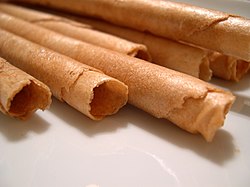Neula
This article has multiple issues. Please help improve it or discuss these issues on the talk page. (Learn how and when to remove these template messages)
|
 | |
| Type | Biscuit |
|---|---|
| Place of origin | Spain |
| Region or state | Catalonia |
| Main ingredients | flour, butter, egg whites, sugar, lemon |
Neula (Catalan pronunciation: [ˈnewlə], plural: neules) is a type of Catalan biscuit, eaten traditionally at Christmas with cava wine, which they are often dipped into, and torró nougat. Neula consists of a very thin sheet of a mixture of egg whites, butter, sugar and flour, flavoured with lemon and rolled.
Other popular versions include neules stuffed with torró de Xixona, or covered with a chocolate lay. Traditionally eaten at Christmas, they are also eaten at other times, sometimes with crema catalana or ice cream.[1][2]
Origin
The noun neula comes from the Latin nebula, meaning "fog", referring to the biscuit's fine and light texture. Some documents show that neules existed before torró, and torró has been shown to exist at least in the Middle Ages and was eaten, for example, at Jaume I's daughter's wedding.
Production
Making neules at home is not easy because of their lightness and slimness, so they are usually bought by Catalonians in professional patisseries.
Other products
In Belgium there are gaufres that, even though they are much thicker and flat, have the same origin as neules. The same origin have other some stuffed or not waffles, as Dutch stroopwafels. In other regions of Spain there are a sort of rolled biscuits called "barquillos", but they are very much stronger, harder and thicker than waffles and neules, bigger than neules and they taste different.
See also
References
- ^ Olesti, Isabel (2005-08-17). "'Neules'". El País (in Spanish). ISSN 1134-6582. Retrieved 2022-07-29.
- ^ "Tossa participa en el B>TRAVEL promocionant els dolços típics de la població". Canal Ajuntament (Tossa de Mar) (in Catalan). Retrieved 2022-07-29.
- CS1 Spanish-language sources (es)
- CS1 Catalan-language sources (ca)
- Articles with short description
- Short description is different from Wikidata
- Articles needing additional references from July 2022
- All articles needing additional references
- Culture articles needing translation from Catalan Wikipedia
- Articles with multiple maintenance issues
- Pages with Catalan IPA
- Articles containing Catalan-language text
- Biscuits
- Catalan cuisine
- Christmas food
- Articles containing video clips